A Predictive Study of a New VCR Engine with High Expansion Ratio and High-Efficiency Potential under Heavy Load Conditions
Abstract
:1. Introduction
- A larger eccentric size increases the max of the OER to 1.17, which increases engine efficiency.
- A larger eccentric size narrows the adjustment range of the eccentric sleeve for the same variation range of the CR and keeps the OER over 1.15 for all conditions.
- The narrower adjustment range of the eccentric sleeve reduces the difficulty of designing the chamber shape and avoids the collision between valves and piston.
2. Design of DSC-VCR
3. Theoretical Thermal Efficiency Calculation of DSC-VCR
- The internal thermal system of the engine, the inner circulation of the turbocharger, and the inter-cooler are regarded as a closed system.
- The combustion process is simplified to a constant volume process. A vibe combustion model based on AVL-BOOST is used as an auxiliary measure to get the related parameters during the whole calculation. The rate of heat release is adjusted to a quite large value, which approximates to a constant volume process.
- The compression and expansion strokes approximate to adiabatic processes. The heat transfer coefficient in the auxiliary model is set to 0.
- The mixture is considered as the ideal gas, and the physical property remains unchanged.
- Friction loss is not taken into account during the whole calculation.
4. The Predictive Simulation
4.1. Model Description
4.1.1. Model of Base Engine
4.1.2. Model of DSC-VCR
4.2. Results and Discussions
4.2.1. Results
4.2.2. Improved Knock Resistance
4.2.3. Effect of Over Expansion
4.2.4. Mechanical Loss
4.2.5. Comparison of Simulation Results
5. Conclusions
- With the improved position of gears, the DSC-VCR allows double, larger size gears to share the load, and the engine can operate with a larger eccentric size and a narrower adjustment range. This helps to reduce the difficulty of designing the chamber shape, avoids the collision between the valves and pistons, and, above all, makes the engine operate with a larger OER under all conditions. Based on the 1.5 T four-cylinder engine, the OER can be increased to over 1.16 with an eccentric size of 6.5 mm.
- According to the theoretical thermal efficiency calculation that considers turbocharging, the per millimeter increase of the eccentric size would improve the theoretical efficiency by 0.0025–0.006. To further improve engine efficiency, increasing the engine load and compression ratio by avoiding knock and using larger eccentric size to increase expansion ratio are the most effective measures.
- The predictive simulation presented the main characteristics of the DSC-VCR. Based on the 1.5 T four-cylinder engine, the reduction of residual gas helps to increase the CR from 9.5 to 10.1 under the full load condition. A larger OER and CR help to reduce the BSFC by 6%–8%. In case of a 75% load, an efficiency increase of about 3.51% was realized.
- The maximum brake efficiency of the DSC-VCR was 40.49% under the 75% load condition. The final efficiency did not seem to be remarkable, because the base engine was just a turbocharging PFI engine with an efficiency of 36.98%. However, the simulation result showed enormous potential for the efficiency improvement of the DSC-VCR under high load conditions. Furthermore, by combining it with other energy-saving technologies such as direct injection, high tumble flow, and stratified or homogeneous lean combustion, the brake efficiency of the DSC-VCR can be expected to achieve even 45% or higher.
Author Contributions
Funding
Acknowledgments
Conflicts of Interest
Acronyms
| VCR | variable compression ratio |
| DSC-VCR | double shaft controlled variable compression ratio |
| VC-T | variable compression turbocharging |
| OER | overexpansion ratio |
| CR | compression ratio |
| BSFC | brake specific fuel consumption |
| HCCI | homogeneous charge compression ignition |
| EGR | exhaust gas recirculation |
| HEV | hybrid electric vehicle |
| NEDC | new European driving cycle |
| WLTC | worldwide-harmonized light vehicles test cycle |
| RDE | real drive emission |
| TDC | top dead left |
| ER | expansion ratio |
| ON | octane number |
| IT | ignition timing |
| TKE | turbulent kinetic energy |
| PFI | Port fuel injection |
Symbols
| the gear load | |
| the summary force of the gas force and inertia force on the piston | |
| the angle between connecting rod and vertical direction | |
| eccentric size | |
| the angle between eccentric sleeve and horizontal direction at compression TDC | |
| . | transmission ratio |
| CR | |
| specific heat ratio | |
| pressure ratio | |
| OER | |
| the volume ratio of the turbine | |
| the compression ratio of the compressor | |
| ignition delay at the unburned zone’s condition | |
| the ratio of temperature decrease of intercooler | |
| the gas pressure | |
| he temperature of unburned zone | |
| Friction | |
| friction coefficient | |
| joint load |
References
- Kojima, S.; Kiga, S.; Moteki, K.; Takahashi, E.; Matsuoka, K. Development of a new 2L gasoline VC-Turbo engine with the world’s first variable compression ratio technology. SAE Tech. Pap. 2018, 1, 0371. [Google Scholar]
- Chiodi, M.; Kaechele, A.; Bargende, M.; Wichelhaus, D.; Poetsch, C. Development of an innovative combustion process: Spark- assisted compression ignition. SAE Int. J. Engines 2017, 10, 5. [Google Scholar] [CrossRef]
- Nakata, K.; Nogawa, S.; Takahashi, D.; Kumagai, A.; Suzuki, T. Engine technologies for achieving 45% thermal efficiency of S.I. engine. SAE Int. J. Engines 2016, 9, 1. [Google Scholar] [CrossRef]
- Ikeya, K.; Takazawa, M.; Yamada, T.; Park, S.; Tagishi, R. Thermal efficiency enhancement of a gasoline engine. SAE Int. J. Engines 2015, 8, 4. [Google Scholar] [CrossRef]
- Puhan, S.; Jegan, R.; Balasubbramanian, K.; Nagarajan, G. Effect of injection pressure on performance, emission and combustion characteristics of high linolenic linseed oil methyl ester in a DI diesel engine. Renew. Energy 2009, 34, 1227–1233. [Google Scholar] [CrossRef]
- Gumus, M. A comprehensive experimental investigation of combustion and heat release characteristics of a biodiesel (hazelnut kernel oil methyl ester) fueled direct injection compression ignition engine. FUEL 2010, 89, 2802–2814. [Google Scholar] [CrossRef]
- Debnath, B.K.; Saha, U.K.; Sahoo, N. Effect of compression ratio and injection timing on the performance characteristics of a diesel engine running on palm oil methyl ester. J. Power Energy 2013, 227, 368–382. [Google Scholar] [CrossRef]
- Costa, R.C.; Sodré, J.R. Compression ratio effects on an ethanol/gasoline fuelled engine performance. Appl. Therm. Eng. 2011, 31, 278–283. [Google Scholar] [CrossRef]
- Chan, C.C.; Bouscayrol, A.; Chen, K. Electric, hybrid, and fuel-cell vehicles: Architectures and modeling. IEEE Ind. Electron. 2010, 59, 589–598. [Google Scholar] [CrossRef]
- Overington, S.; Rajakaruna, S. High-efficiency control of internal combustion engines in blended charge depletion/charge sustenance strategies for plug-in hybrid electric vehicles. IEEE Ind. Electron. 2015, 64, 48–61. [Google Scholar] [CrossRef]
- Kawamoto, N.; Naiki, K.; Kawai, T.; Shikida, T.; Tomatsuri, M. Development of new 1.8-liter engine for hybrid vehicles. SAE Tech. Pap. 2009, 1, 1061. [Google Scholar]
- Kitayama, S.; Saikyo, M.; Nishio, Y.; Tsutsumi, K. Torque control strategy and optimization for fuel consumption and emission reduction in parallel hybrid electric vehicles. Struct. Multidisc. Optim. 2015, 52, 595. [Google Scholar] [CrossRef]
- Mendler, C.; Gravel, R. Variable Compression Ratio Engine. SAE Tech. Pap. 2002, 1, 1940. [Google Scholar]
- Kentfield, J.A.C. Extended, and Variable, Stroke Reciprocating Internal Combustion Engines. SAE Tech. Pap. 2002, 1, 1941. [Google Scholar]
- Dennis, N.; Assanis, W.C.; Choi, I.; Ickes, A.; Jung, D.; Martz, J.; Nelson, R.; Sanko, J.; Thompson, S.; Brevick, J.; et al. Pressure Reactive Piston Technology Investigation and Development forSpark Ignition Engines. SAE Tech. Pap. 2005, 1, 1648. [Google Scholar]
- Boretti, A.; Scalzo, J. Exploring the Advantages of Variable Compression Ratio in Internal Combustion Engines by Using Engine Performance Simulations. SAE Tech. Pap. 2011, 1, 364. [Google Scholar]
- Kadota, M.; Ishikawa, S.; Yamamoto, K.; Kato, M.; Kawajiri, S. Advanced control system of variable compression ratio (VCR) engine with dual piston mechanism. SAE Tech. Pap. 2009, 2, 1009–1018. [Google Scholar] [CrossRef]
- Will, F.S.; Mayson, D. Combustion Simulations for a Self Controlling Variable Compression Ratio Connecting Rod. SAE Tech. Pap. 2012, 1, 1154. [Google Scholar]
- Kleeberg, H.; Tomazic, D.; Dohmen, J.; Wittek, K.; Balazs, A. Increasing efficiency in gasoline powertrains with a two-stage variable compression ratio (VCR) system. SAE Tech. Pap. 2013, 1, 288. [Google Scholar]
- Duchemin, M.; Collee, V. Profile optimization of the teeth of the double rack-and-pinion gear mechanism in the MCE-5 VCRi engine. SAE Int. J. Engines 2016, 9, 1786–1794. [Google Scholar] [CrossRef] [Green Version]
- Leithinger, S.F. Reciprocating Piston Type Internal Combustion Engine with Variable Compression Ratio. U.S. Patent 5,908,014, 1 June 1999. [Google Scholar]
- De Gooijer, B. VCR breakthrough. Engine Technol. Int. 2014, pp. 58–59. Available online: https://www.ukimediaevents.com/publication/e5b6bd2e/56 (accessed on 31 March 2020).
- De Gooijer, B. New GoEngine VCR development. Engine Technol. Int. 2010, 1, 42–44. [Google Scholar]
- Gomecsys Homepage. Available online: https://gomecsys.com/our-product/gomecsys-vcr-technology (accessed on 29 November 2019).
- Lin, J. Compression-ratio-adjustable engine capable of being suitable for any crankshaft overlapping degree without damaging crankshaft structure. Patent CN203879624U, 15 October 2014. [Google Scholar]
- Goto, T.; Isobe, R.; Yamakawa, M.; Nishida, M. The new Mazda gasoline engine skyactiv-G. Auto Technol. 2011, 11, 40–47. [Google Scholar]
- Yamada, T.; Adachi, S.; Nakata, K.; Kurauchi, T.; Takagi, I. Economy with superior thermal efficient combustion (ESTEC). SAE Tech. Pap. 2014, 1, 1192. [Google Scholar]
- AVL. BOOST Ver. 5.1 User Guide. Available online: 0H0H0Hhttp://www.avl.com (accessed on 31 March 2020).
- Sander, D.E.; Allmaier, H.; Priebsch, H.H.; Reich, F.M.; Witt, M.; Füllenbach, T.; Skiadas, A.; Schwarze, H. Impact of high pressure and shear thinning on journal bearing friction. Tribol. Int. 2015, 81, 29–37. [Google Scholar] [CrossRef]
- Gomecsys Homepage. Available online: http://www.gomecsys.com/#home/product (accessed on 30 June 2015).
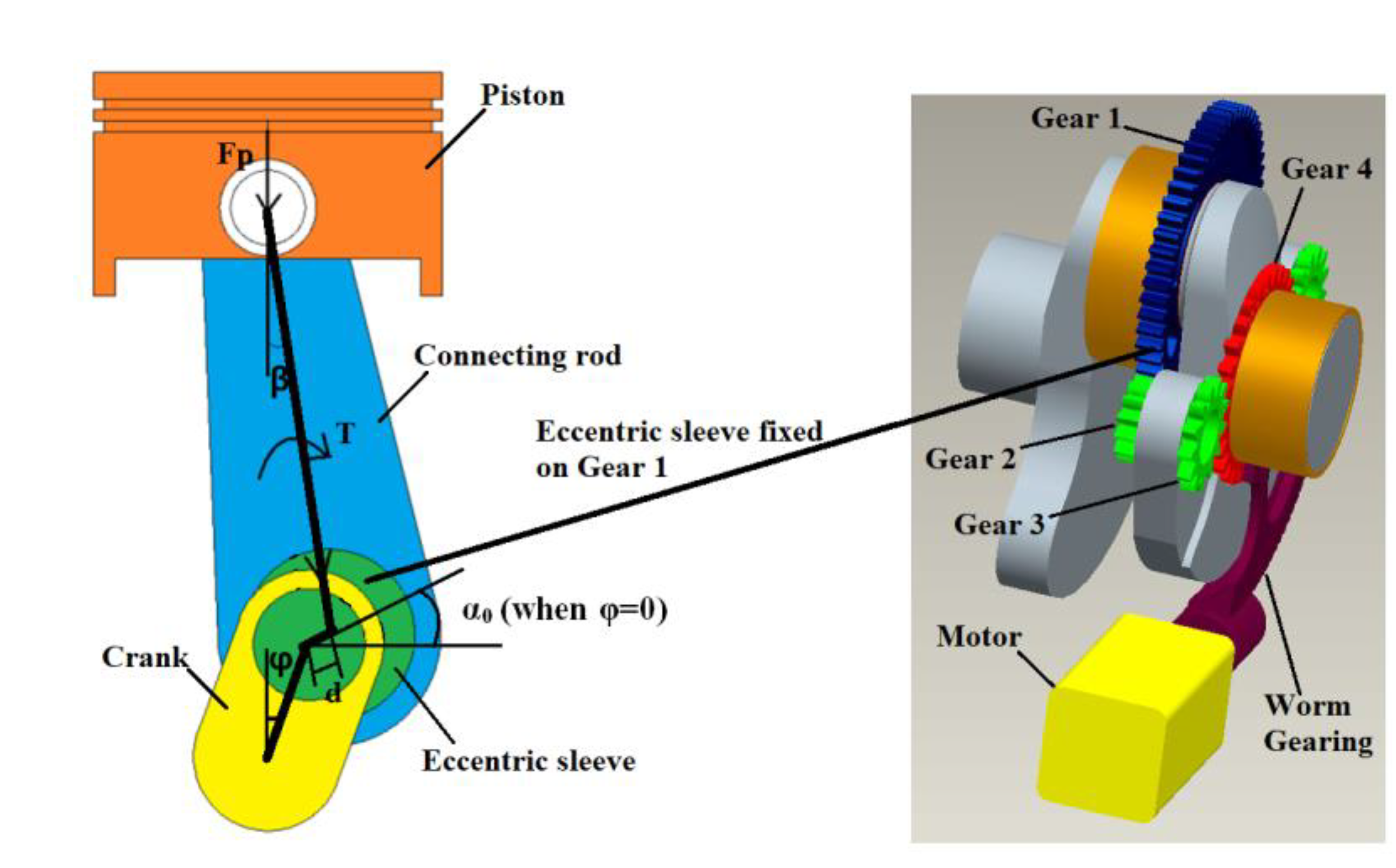

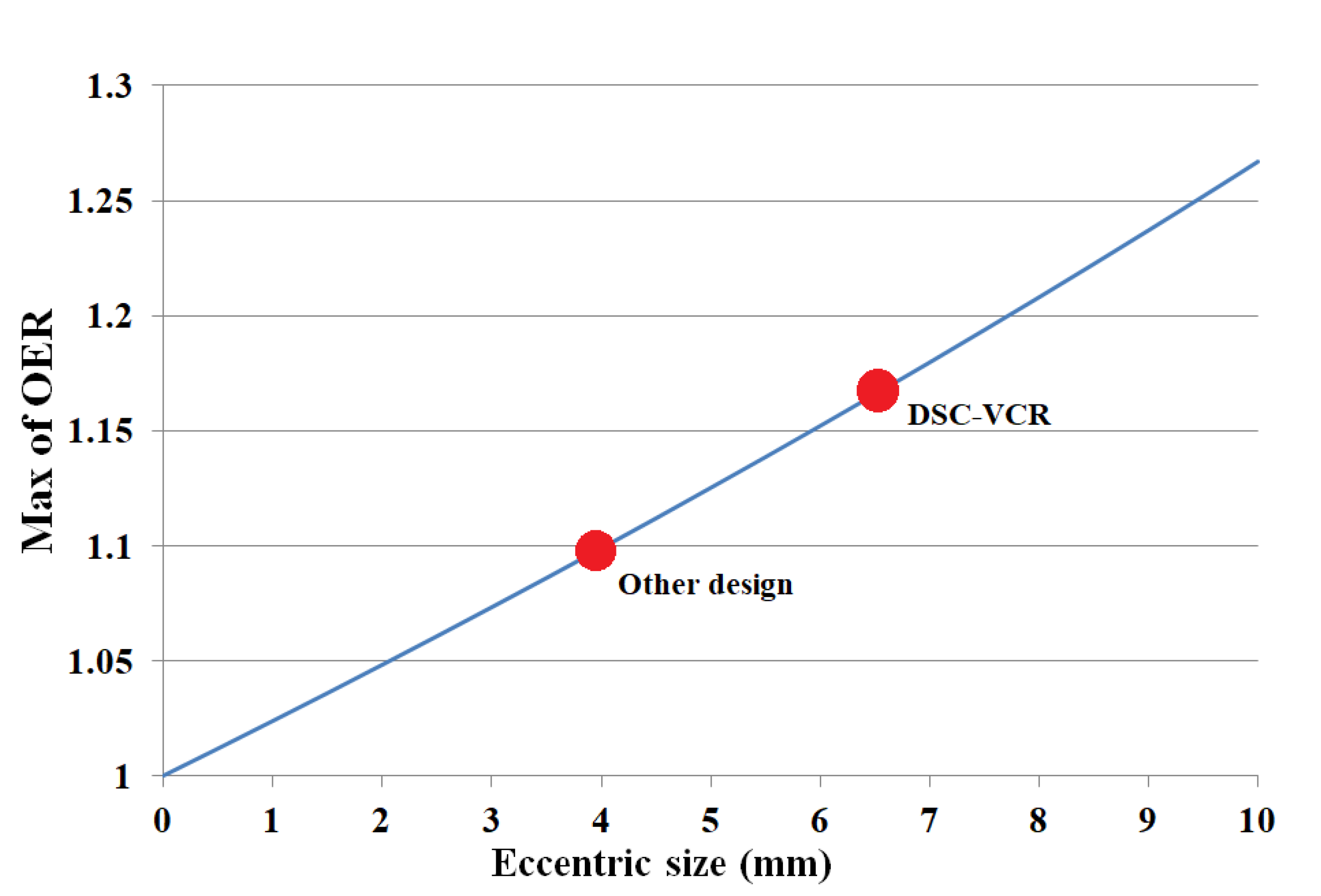

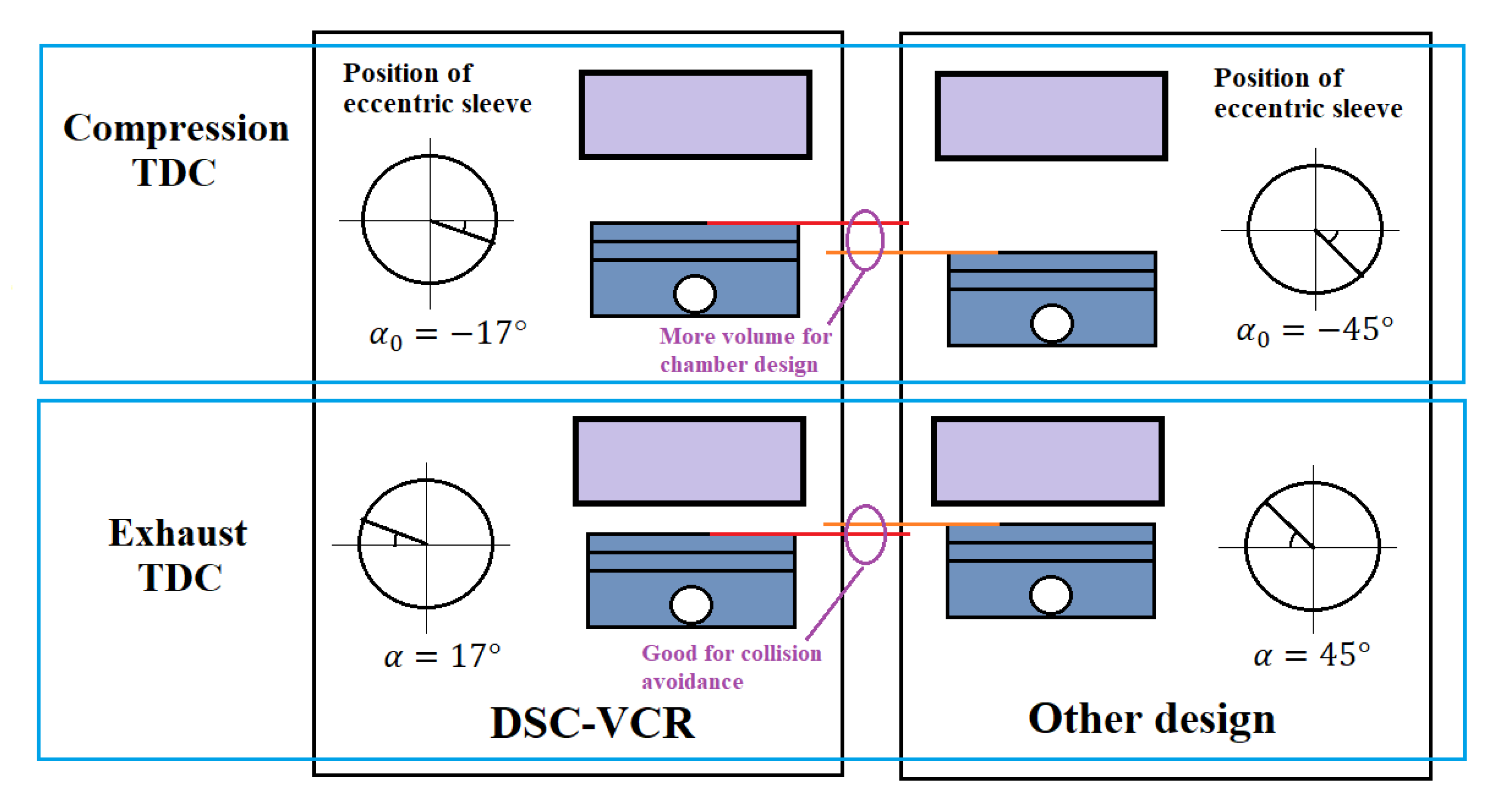

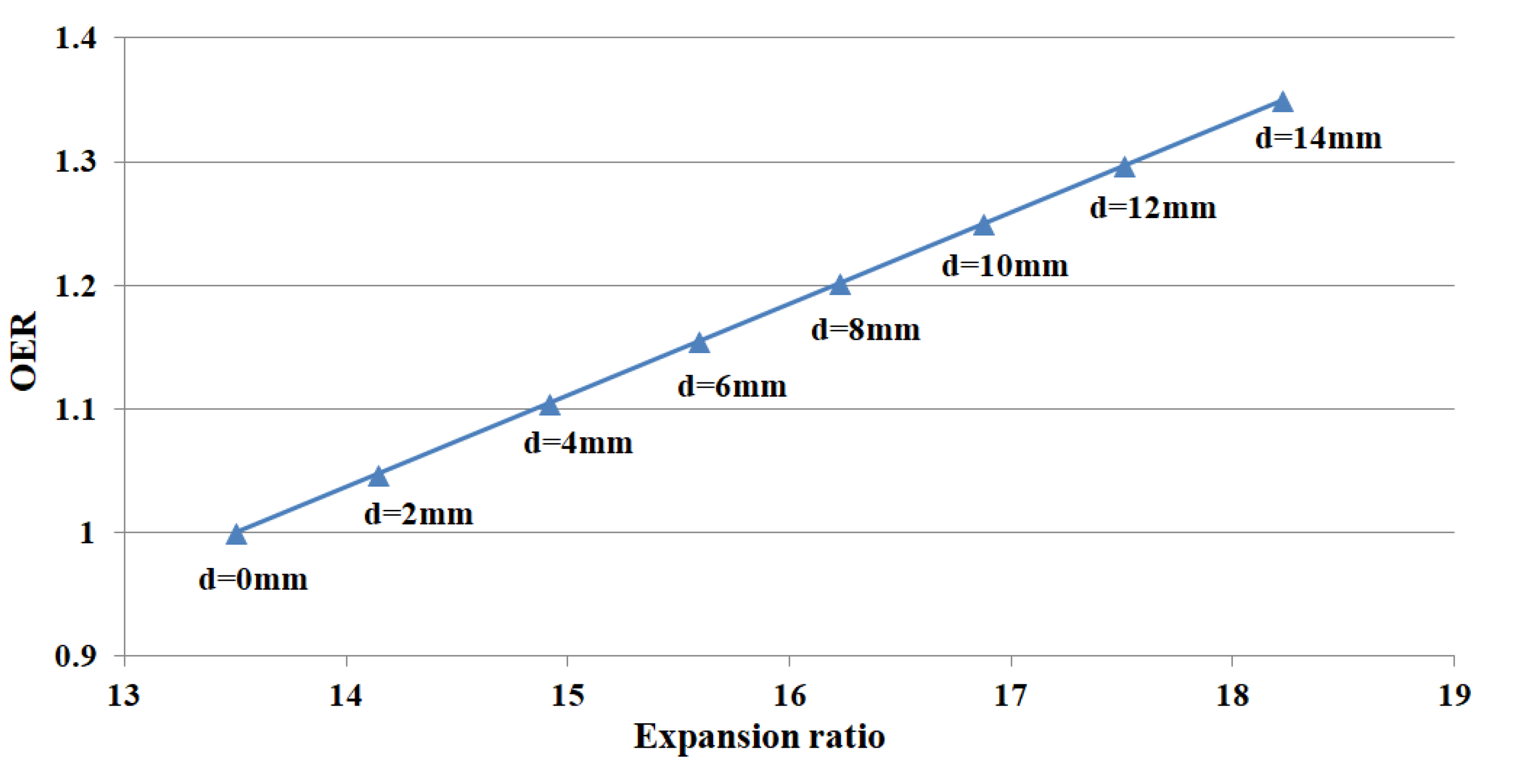

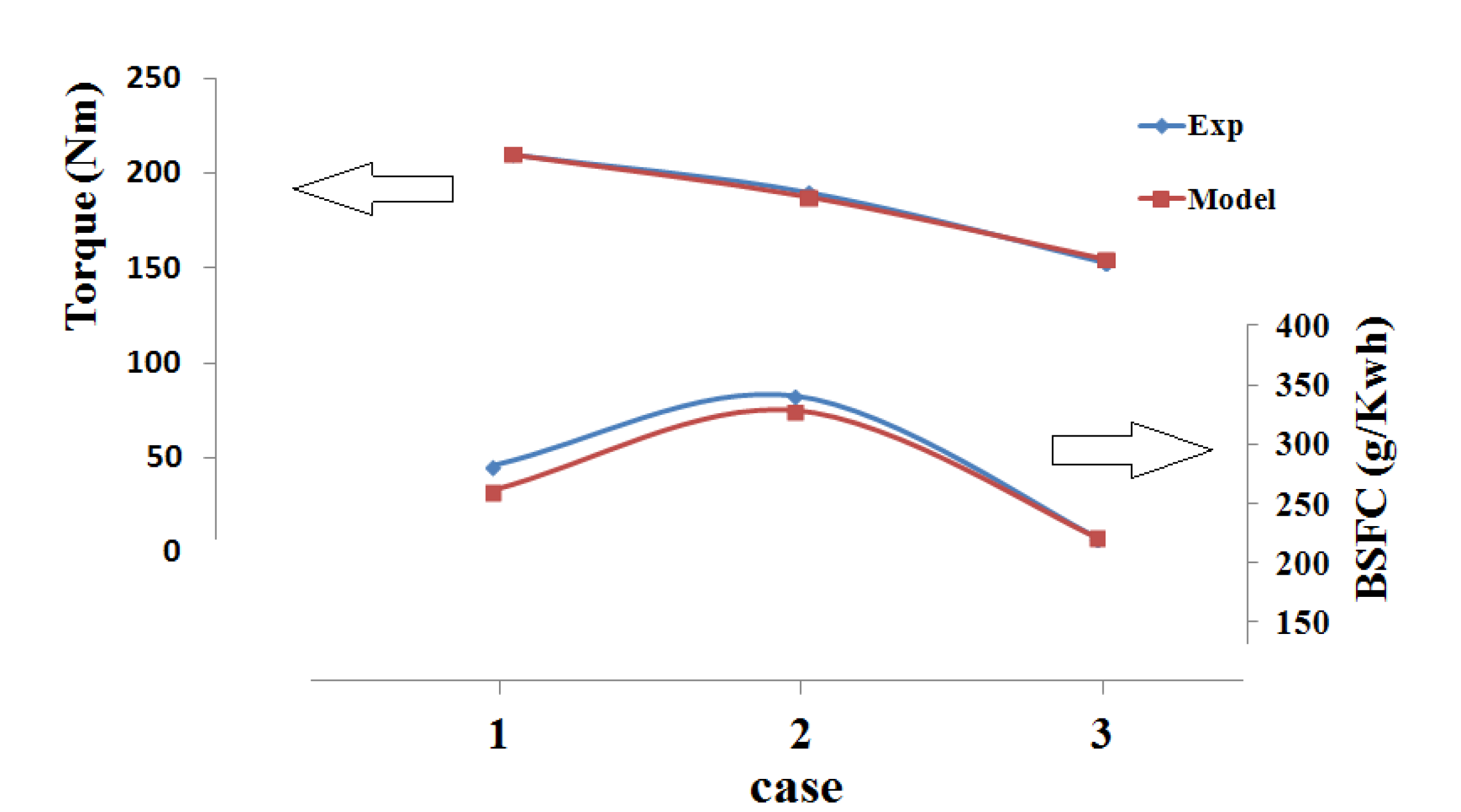
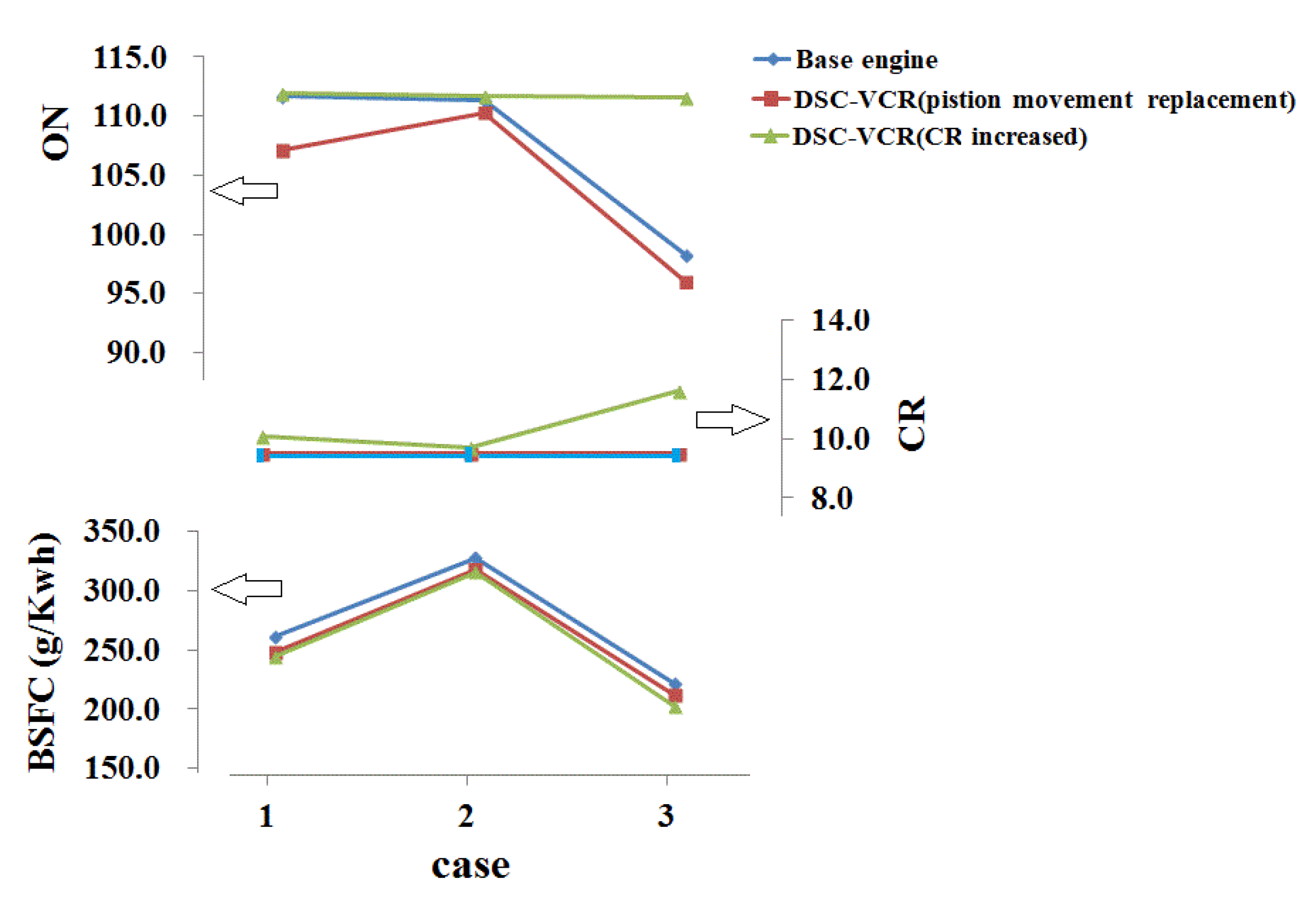






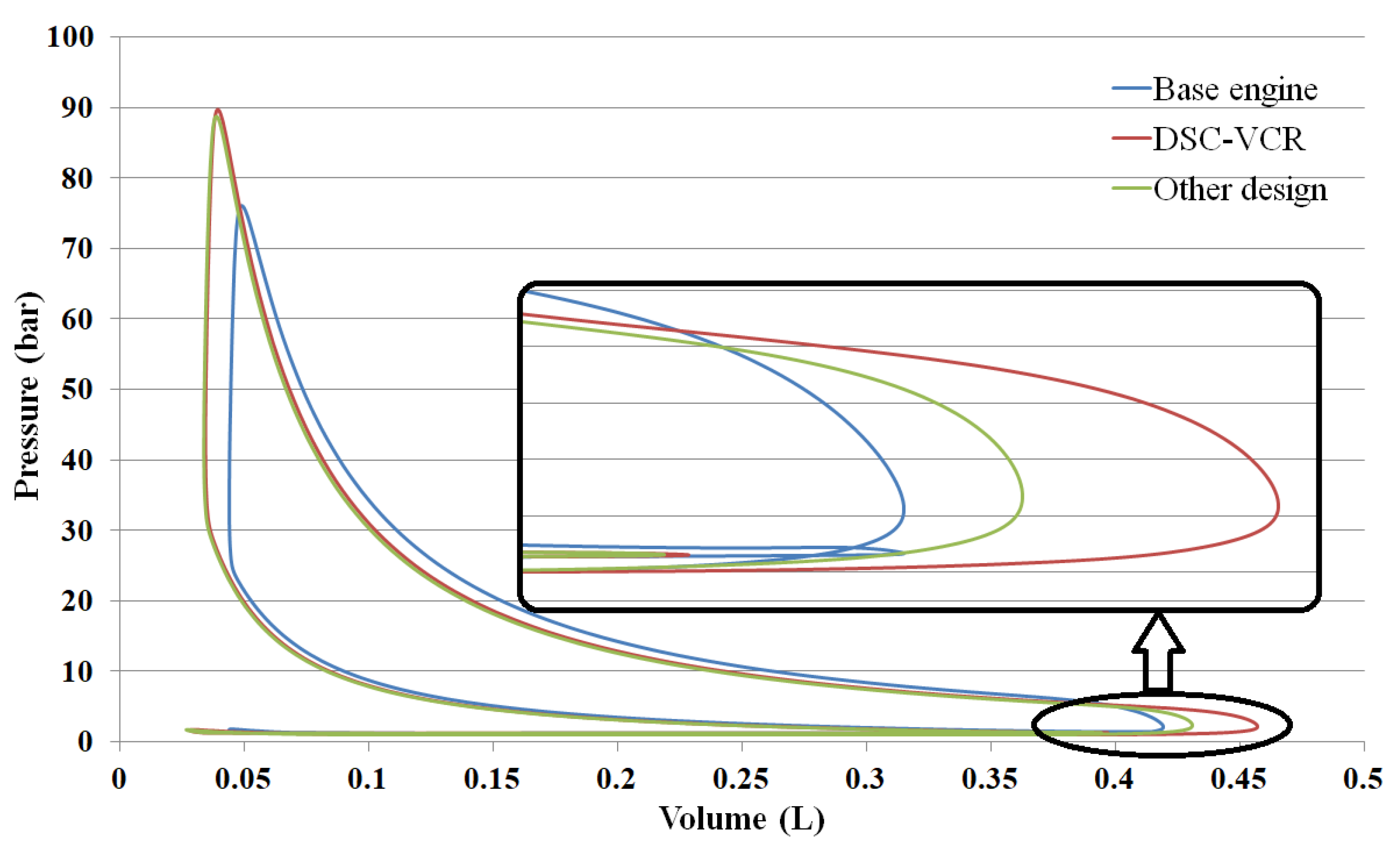
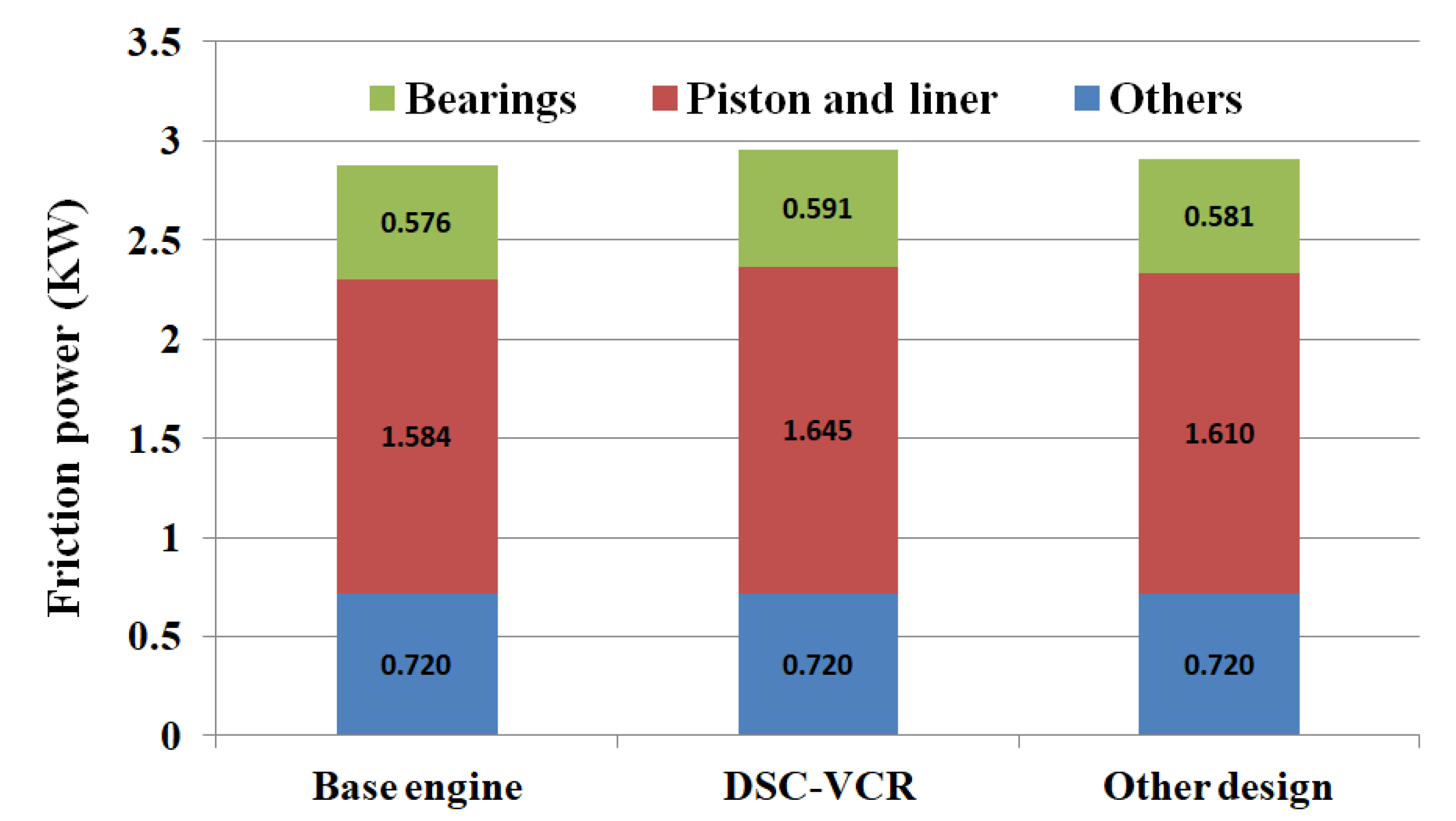
| (mm) | CR | ER | Crank Radius (mm) | Intake Stroke (mm) | OER | |
|---|---|---|---|---|---|---|
| 4 | −45 | 9.5 | 10.23 | 40.25 | 80.5 | 1.076 |
| −2 | 13.5 | 14.91 | 40.25 | 76.64 | 1.105 | |
| 18 | 17.46 | 19.17 | 40.25 | 75.46 | 1.098 | |
| 8 | −15 | 9.5 | 11.42 | 43.08 | 80.56 | 1.202 |
| 4 | 13.5 | 16.13 | 43.08 | 77.62 | 1.203 | |
| 16 | 17.5 | 21.53 | 43.08 | 76.42 | 1.191 | |
| 12 | −11 | 9.5 | 12.45 | 44.99 | 80.49 | 1.31 |
| 2 | 13.6 | 17.76 | 44.99 | 77.57 | 1.306 | |
| 9 | 17.6 | 23.07 | 44.99 | 76.25 | 1.296 |
| Engine Load | 100% | 75% | 50% | 30% | 10% |
|---|---|---|---|---|---|
| 4.415 | 3.862 | 4.441 | 4.099 | 3.377 | |
| 2.01 | 1.57 | 1 | 1 | 1 | |
| 1.2 | 1.129 | 1 | 1 | 1 | |
| 1.58 | 1.6 | 1 | 1 | 1 |
| Stroke (mm) | 80.5 |
| Bore (mm) | 77 |
| No. of cylinders | 4 |
| Displacement (L) | 1.5 |
| Compression ratio | 9.5 |
| No. of valves | 4 |
| Valve train type | DVVT |
© 2020 by the authors. Licensee MDPI, Basel, Switzerland. This article is an open access article distributed under the terms and conditions of the Creative Commons Attribution (CC BY) license (http://creativecommons.org/licenses/by/4.0/).
Share and Cite
Lin, J.; Yang, S. A Predictive Study of a New VCR Engine with High Expansion Ratio and High-Efficiency Potential under Heavy Load Conditions. Energies 2020, 13, 1655. https://doi.org/10.3390/en13071655
Lin J, Yang S. A Predictive Study of a New VCR Engine with High Expansion Ratio and High-Efficiency Potential under Heavy Load Conditions. Energies. 2020; 13(7):1655. https://doi.org/10.3390/en13071655
Chicago/Turabian StyleLin, Jiansheng, and Shu Yang. 2020. "A Predictive Study of a New VCR Engine with High Expansion Ratio and High-Efficiency Potential under Heavy Load Conditions" Energies 13, no. 7: 1655. https://doi.org/10.3390/en13071655
APA StyleLin, J., & Yang, S. (2020). A Predictive Study of a New VCR Engine with High Expansion Ratio and High-Efficiency Potential under Heavy Load Conditions. Energies, 13(7), 1655. https://doi.org/10.3390/en13071655





